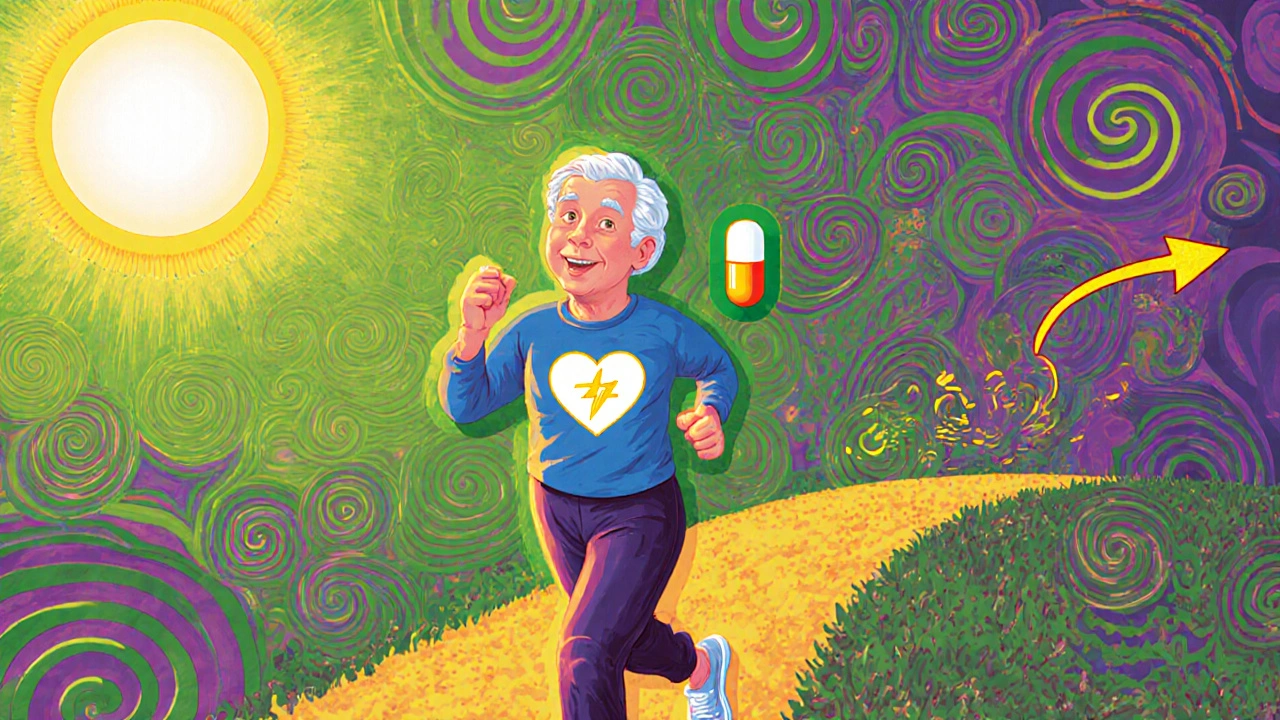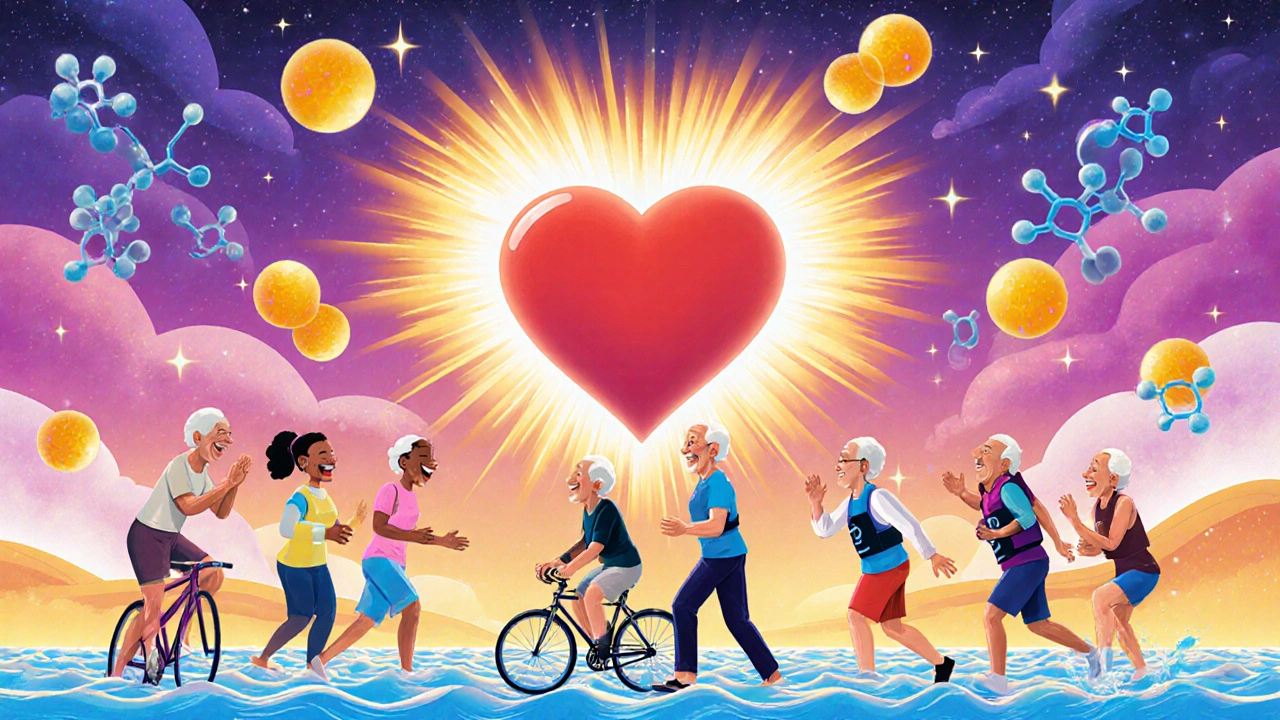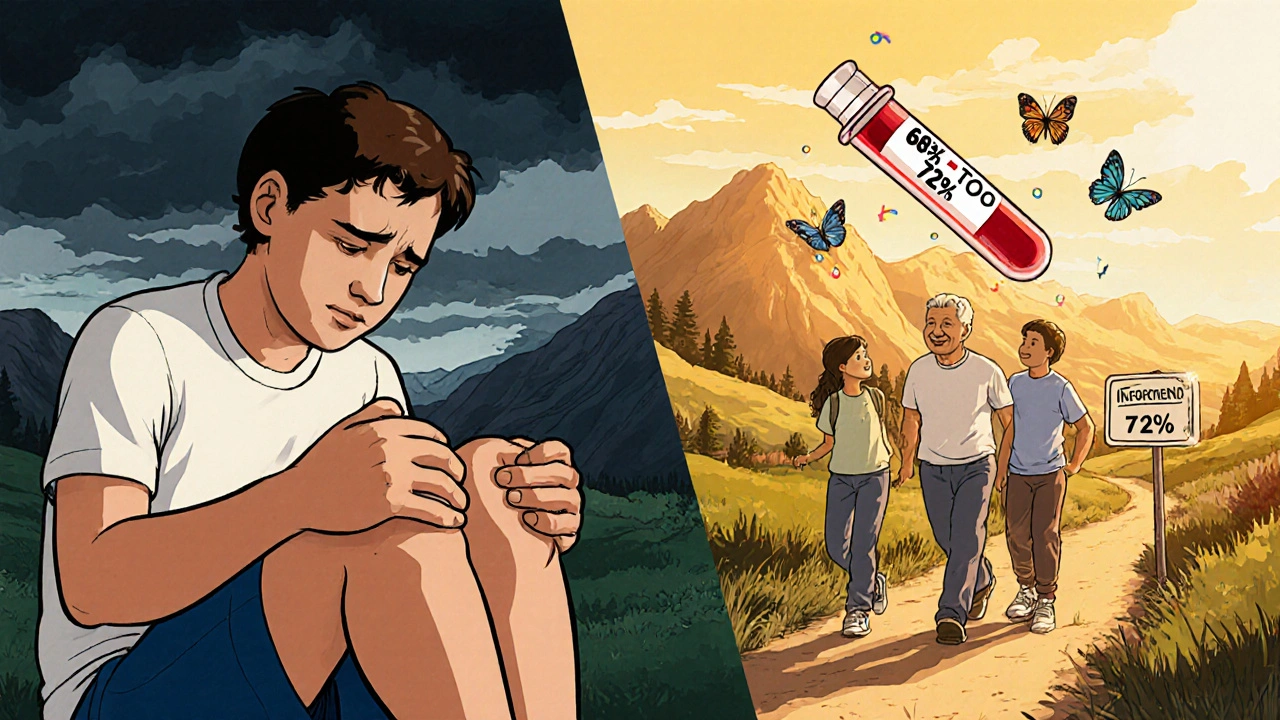Statins and Exercise: How to Prevent Muscle Injury While Staying Active
 Nov, 24 2025
Nov, 24 2025
Statin Exercise Safety Calculator
Personalized Exercise Safety Guide
Determine your safe exercise intensity while on statins based on your age, statin type, and current fitness level. Based on research from the Journal of the American College of Cardiology.
Many people on statins worry that working out will hurt their muscles. You’ve probably heard stories-someone stopped running because their legs felt like lead, or a friend quit the gym after their doctor warned them about statin muscle pain. The truth is more nuanced: statins and exercise can coexist safely, but only if you know how to manage the risks. You don’t have to give up movement to protect your heart. In fact, staying active is one of the best things you can do while on statins.
Why Statins Might Affect Your Muscles
Statins work by blocking an enzyme in your liver that makes cholesterol. But that same enzyme is also involved in making coenzyme Q10 (CoQ10), a compound your muscles need for energy. When CoQ10 drops, some people notice their muscles feel tired, sore, or weak-especially after exercise. This isn’t true muscle damage for most, but it feels like it. About 1 in 10 people on statins report muscle symptoms, and physical activity can make those feelings worse. Not all statins are the same. Lipophilic ones like simvastatin and atorvastatin enter muscle tissue more easily, which may explain why they’re linked to more muscle complaints. Hydrophilic statins like rosuvastatin and pravastatin stay mostly in the liver and are less likely to cause trouble. If you’re struggling with soreness, switching statins could help-talk to your doctor.Exercise Isn’t the Enemy-Too Much Too Soon Is
Research from the Journal of the American College of Cardiology in 2023 followed 100 adults aged 55 to 73 who were on statins. They cycled at a moderate pace for 45 minutes-about 60% of their max effort. Afterward, muscle strength didn’t drop. But one marker of muscle recovery, called half-relaxation time, did slow down in statin users. That means their muscles took longer to relax after contracting. It’s a subtle change, not a sign of injury. And crucially, people who felt muscle pain before exercise didn’t feel worse afterward. The real problem? High-intensity workouts. A 2010 study of Boston Marathon runners found statin users had significantly higher levels of creatine kinase (CK)-a protein that leaks into the blood when muscles are stressed. Older runners were especially affected. But here’s the catch: those elevated CK levels didn’t always mean they lost strength or couldn’t move normally. Muscle damage markers don’t always match how you feel. Bottom line: moderate exercise is safe. Vigorous, sudden, or prolonged effort increases risk.How to Exercise Safely on Statins
You don’t need to stop moving. You just need to adjust how you move.- Keep it moderate. Aim for a pace where you can talk but not sing. That’s about 5 to 6 on a 10-point effort scale. Walking, cycling, swimming, or light resistance training are ideal. Avoid sprinting, heavy lifting, or HIIT until you’ve built up tolerance.
- Start slow and build up. If you’re new to exercise or restarting after a break, increase your time or intensity by no more than 10% per week. A 2010 mouse study showed that animals trained gradually didn’t lose muscle strength even when given statins. Humans likely respond the same way.
- Time your workouts. Most statins peak in your bloodstream 2 to 4 hours after you take them. If possible, exercise before your dose or wait 4 to 6 hours after. This isn’t proven, but it’s a simple adjustment that some people find helpful.
- Check your vitamin D. Low vitamin D is linked to higher muscle pain in statin users. Get your levels tested. If you’re below 30 ng/mL, your doctor may recommend a supplement. Many people feel better once they fix this.
- Avoid certain drugs. Fibrates (like gemfibrozil) used for triglycerides can multiply your risk of muscle injury when taken with statins. If you’re on both, talk to your doctor about alternatives.

Listen to Your Body-But Don’t Panic
Muscle soreness after exercise is normal. But if your pain lasts more than 72 hours, gets worse, or is accompanied by dark urine (like cola), stop exercising and call your doctor. That could be rhabdomyolysis-a rare but serious condition where muscle breaks down and floods your bloodstream. Most people don’t get this. But it’s why you need to know the warning signs. Don’t ignore pain that doesn’t go away. At the same time, don’t assume every ache means you’re harming yourself. A 2023 survey of statin users found that 68% were afraid to exercise because of muscle concerns. But among those who stuck with moderate activity for six months, 72% said their muscles adapted-they felt less sore, had more energy, and could move easier. Your body can adjust. Give it time.What About Stopping Statins?
Some people quit their statins because they think exercise is too risky. That’s the wrong move. Statins reduce heart attacks and strokes by 25% to 35%. Regular exercise reduces those same risks by 20% to 30%. Together, they’re powerful. Quitting statins for fear of muscle pain puts your heart at greater risk than continuing them. A 2022 JAMA editorial put it plainly: “Discontinuing exercise would be more harmful than continuing statin therapy.” The benefits of both far outweigh the risks-if you manage them wisely.
What’s Next? New Research and Hope
Scientists are still digging deeper. The STATIN-EX trial, running until late 2025, is studying 300 people on statins doing different types of exercise. Early data suggests genetics play a role-some people have a gene variant (SLCO1B1) that makes them more sensitive to statin muscle effects. In the future, a simple blood test might tell you if you’re at higher risk. Also, newer guidelines from the European Atherosclerosis Society in 2024 are expected to recommend hydrophilic statins (rosuvastatin, pravastatin) as first choices for active people. They cause fewer muscle symptoms during exercise. And pharmaceutical companies are stepping up. Pfizer’s patient education program saw a 22% increase in exercise adherence after doctors gave clear advice on safe activity. Knowledge reduces fear.Real Talk: What Works for People Like You
People in online forums like Reddit’s r/Statins share the same patterns: those who switched from HIIT to daily walks or light cycling saw a 60% drop in muscle complaints. One 68-year-old man in Bristol stopped running after his CK levels spiked. He started swimming three times a week, added a daily 30-minute walk, and now says he feels stronger than he has in years. Another woman, 72, was told to stop statins because of muscle pain. She switched to pravastatin, started walking with a weighted vest, and took vitamin D. Six months later, she hiked a mountain trail with her grandchildren. You don’t need to be an athlete. You just need to move consistently, safely, and without fear.Can I still run if I’m on statins?
You can, but proceed with caution. Running, especially long distances or at high intensity, increases muscle injury markers like CK. If you’re over 60 or have had muscle pain before, switch to brisk walking, cycling, or swimming. If you want to keep running, do it slowly, build up over months, and monitor how you feel. Stop and call your doctor if you notice dark urine or pain lasting more than 3 days.
Does every statin cause muscle pain?
No. Statins vary in how likely they are to cause muscle symptoms. Lipophilic statins like simvastatin and atorvastatin are more likely to cause issues because they enter muscle tissue easily. Hydrophilic statins like rosuvastatin and pravastatin stay mostly in the liver and are better tolerated during exercise. If you’re having trouble, ask your doctor about switching.
Should I take CoQ10 supplements with statins?
Some people report feeling better on CoQ10, but studies haven’t proven it consistently helps with statin muscle pain. It’s not a magic fix. If you want to try it, choose a reputable brand and talk to your doctor. Better yet, focus on what’s proven: moderate exercise, vitamin D, and avoiding overtraining.
How do I know if my muscle pain is from statins or just aging?
Normal aging causes gradual stiffness and slower recovery. Statin-related pain usually starts or worsens after you begin the medication, and it often feels deeper and more persistent. If the pain began after starting statins and improves after stopping them (under medical supervision), it’s likely related. Blood tests for CK can help, but they’re not always reliable. Your symptoms and timing matter more than any single number.
Can I stop statins if I exercise more?
No. Exercise doesn’t replace statins. Statins lower LDL cholesterol directly, which reduces your risk of heart attack and stroke. Exercise improves heart health in other ways-lowering blood pressure, improving insulin sensitivity, reducing inflammation. They work together. Stopping statins because you’re exercising puts you at higher risk for cardiovascular events. Talk to your doctor about adjusting your dose or switching medications instead.
Pallab Dasgupta
November 25, 2025 AT 19:42Bro, I was terrified to lift after starting simvastatin-felt like my legs were made of wet concrete. Started walking 30 mins a day, no rush. After 3 weeks, I could barely tell I was on statins. Your body ain’t broken, it’s just recalibrating. Keep moving, but don’t be a hero.
Lisa Odence
November 26, 2025 AT 14:27While I appreciate the general sentiment conveyed herein, I must assert-based upon a comprehensive review of the current literature, including meta-analyses from the Journal of Clinical Lipidology (2022), the European Journal of Preventive Cardiology (2023), and the ACC/AHA guidelines-that the assertion regarding hydrophilic statins being 'better tolerated' is statistically substantiated only within a narrow cohort of patients with pre-existing myopathy or SLCO1B1 polymorphisms. Moreover, the notion that 'moderate exercise' is universally safe is an oversimplification, as individualized pharmacokinetic profiles, renal clearance rates, and concomitant medication use (e.g., amiodarone, cyclosporine) may significantly alter risk thresholds. One cannot generalize across a population of over 400 million statin users without stratification.
Rachel Villegas
November 26, 2025 AT 22:44I’ve been on pravastatin for 5 years. Walked 5 miles every morning. Never had a problem. I think people panic too much. Your muscles aren’t fragile. Just don’t go from zero to marathon in a week.
Jefriady Dahri
November 28, 2025 AT 07:40Man, I was 62, on simva, and thought I’d never jog again. Started with 10 minutes a day. Then 15. Then 20. Now I do 45. No pain. No drama. Just consistency. And yeah, I take vitamin D. 5000 IU. My doc tested me. Don’t guess. Get checked. You got this. 💪
Archana Jha
November 29, 2025 AT 05:04Statins are just a gateway drug for Big Pharma to sell you CoQ10 and vitamin D supplements. They don't want you to know that muscle pain is your body saying 'STOP'-but instead they push you to 'adjust' and 'stay active' like some corporate wellness bot. The real cause? Statins mess with your mitochondria. They're basically slow poison. And they'll tell you it's 'normal' until you're in the hospital with rhabdo. Ask yourself: why do they call it 'statin myopathy' and not 'statin toxicity'?
Shirou Spade
November 29, 2025 AT 15:48There’s a quiet wisdom in moving slowly. Not because you’re weak, but because you’re wise. The body doesn’t need grand gestures to heal-it needs rhythm. Statins are a tool, not a sentence. Exercise isn’t punishment-it’s conversation. Listen to the ache, don’t scream at it. Some days, walking is the bravest thing you can do. And that’s okay.
Josh Zubkoff
November 29, 2025 AT 19:29Look, this whole article is just a glorified statin ad. They say 'exercise is safe' but the fine print is: 'if you don't die from rhabdo.' I've seen three guys in my gym quit because their CK levels went through the roof. And yeah, they told them to 'try rosuvastatin'-like that's some magic bullet. Newsflash: your liver doesn't care if you're 'active.' It just metabolizes. And if you're over 60, your muscles aren't 25-year-old muscle. They're tired. And the system knows it. This isn't empowerment. It's gaslighting with citations.
Aki Jones
November 30, 2025 AT 18:10Let’s be real: the FDA’s own data shows that statin-related muscle injury is underreported by 78% because patients are told it’s ‘normal aging’ or ‘just soreness.’ The 2023 JAMA editorial? Written by a cardiologist who takes statins. Conflict of interest? Oh, they’ll say ‘no.’ But the pharmaceutical funding? That’s in the appendix no one reads. And the STATIN-EX trial? Funded by AstraZeneca. Of course they’ll say ‘hydrophilic statins are better.’ They make them. And vitamin D? That’s a placebo with a side of hope. Don’t be fooled. This isn’t medicine-it’s marketing dressed in peer-reviewed clothing.
Ellen Sales
December 2, 2025 AT 02:17I switched from atorvastatin to pravastatin after 6 months of constant leg cramps. Started walking 20 minutes a day. Then added light bands. Now I do yoga. I didn’t know vitamin D was low until my blood test. 22 ng/mL. Took 5000 IU daily. Within 3 weeks, the 'heavy legs' feeling? Gone. I didn’t need to stop moving. I just needed to stop ignoring my body. And honestly? I feel better now than I did before statins. It’s not about giving up. It’s about changing how you move.
Andrew McAfee
December 3, 2025 AT 22:45Here in the States we treat exercise like a competition. In India, my cousin walks 6 km every morning with his chai. No timer. No app. Just movement. He’s 70. On simvastatin. No pain. He doesn’t care about CK levels. He cares about seeing the sunrise. Maybe the real secret isn’t the drug or the workout. It’s just showing up. Slowly. Every day.
Elise Lakey
December 4, 2025 AT 05:30One thing I wish more people said: it’s okay to take a week off. I thought if I stopped moving, I’d lose all progress. But after a 5-day break during a bad flare-up, I came back stronger. Not because I did more-but because I listened. Statins don’t make you weak. Fear does.
Amy Hutchinson
December 4, 2025 AT 20:13wait so if i stop running and just walk will my heart still be protected??? like i dont wanna die but i also dont wanna feel like my legs are breaking??
Jefriady Dahri
December 5, 2025 AT 09:34yes. 100%. walking is the MVP. i did 30 mins every day for 6 months. no running. no lifting. just walking. my heart? better. my legs? better. my doc said my LDL dropped 15%. you don’t need to run to save your heart. you just need to move. and breathe. and not panic.